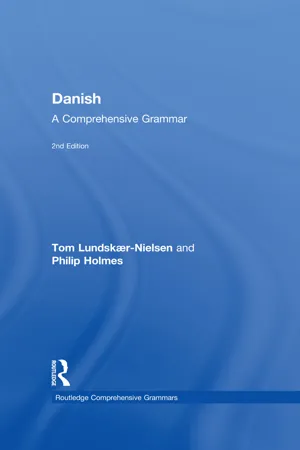
- 752 pages
- English
- ePUB (mobile friendly)
- Available on iOS & Android
Danish: A Comprehensive Grammar
About This Book
Danish: A Comprehensive Grammar presents a fresh and accessible description of the language, concentrating on the real patterns of use in modern Danish. The volume is organized to promote a thorough understanding of Danish grammar. It offers a stimulating analysis of the complexities of the language, and provides full and clear explanations.
This edition has been fully updated to reflect changes in grammar, cultural changes and the impact of modern technology. All sections have been systematically revised, and a new section on phrases and an up-to-the-moment account of the use of the comma have been added. The examples and grammar explanations have been improved throughout.
Features include:
-
- a wealth of examples from present-day Danish
- particular attention to areas of confusion and difficulty
- Danish-English parallels highlighted throughout the book
- an extensive index and clear paragraph numbering for easy navigation
- cross-references in all parts of the book.
Danish: A Comprehensive Grammar is the most comprehensive and detailed Danish grammar available in English and is an essential reference source for the learner and user of Danish at all levels. It is ideal for use in schools, colleges, universities and adult classes of all types.
Frequently asked questions
Information
Chapter 1
Nouns
1.1 Introduction
1.1.1 Different types of noun
- – Some abstracts are count nouns: farve, colour; glæde, joy; sygdom, illness
- – Some abstracts are non-count nouns: hvidhed, whiteness; lykke, happiness; musik, music
1.1.2 Genders
| en hånd, a hand | hånden, the hand |
| en pige, a girl | pigen, the girl |
| et hus, a house | huset, the house |
| et æble, an apple | æblet, the apple |
1.1.3 Indefinite plural forms
1.1.4 Cases
| en pige, a girl | en piges hånd, a girl’s hand |
| pigen, the girl | pigens hånd, the girl’s hand |
| piger, girls | pigers hænder, girls’ hands |
| pigerne, the girls | pigernes hænder, the girls’ hands |
1.2 Gender rules
1.2.1 Introduction
| en stor bil | et stort hus |
| a big car | a big house |
| bilen er stor | huset er stort |
| the car is big | the house is big |
| dagen – han, the day... |
Table of contents
- Cover
- Title
- Copyright
- Contents
- Preface
- Symbols and abbreviations used in the text
- Chapter 1 Nouns
- Chapter 2 Adjectives
- Chapter 3 Numerals
- Chapter 4 Pronouns
- Chapter 5 Verbs
- Chapter 6 Adverbs
- Chapter 7 Prepositions
- Chapter 8 Interjections
- Chapter 9 Conjunctions
- Chapter 10 Sentence structure and word order
- Chapter 11 Word formation
- Chapter 12 Punctuation
- Chapter 13 Orthography
- Linguistic terms
- Latin, Danish and English linguistic terms
- Short bibliography
- Index